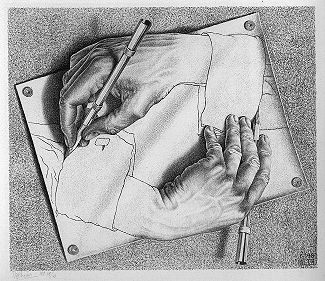Image: Deru/Tim Navis
What we know for sure is that what comes next is going to be huge and nothing will ever be the same again.
This statement, possibly the dominant sentiment of the post-industrial world, is what it means to be defined by technology: neverending expectation, the assurance that this here now is insufficient, a mere stepping stone to the real future‘s future.
It’s a perfect strange loop: as we progress upward through hierarchies of new and better technology, we’re also conditioned by that same new and better technology to anticipate the next wave of new and better. The real future is always just over the horizon and it’s such that we’re rarely impressed by anything, no matter how much things actually change and move forward within technology. There is no techno-future, just a dull yet anxiety-inducing present. It’s like a Sheperd tone, a small set of static musical notes arranged just right so that they sound as if they’re always rising.
The trick is that the tones never really move, nor is it quite all in your head either. Such is a strange loop.
This is the experience of the new video from Los Angeles-based producer Deru and visual artist Anthony Ciannamea, for Deru’s track, “The Future Never Comes.” The song advances in slowly-unfolding wide-angle loops, as does the accompanying video’s night driver, heading always toward some far horizon of light and noise, or perhaps even something more disastrous. Subtly, the tension builds, while only stuttering fragments are revealed.
“The Future Never Comes” is from Deru aka Benjamin Wynn’s forthcoming 1979 LP, and the video above (premiered at XLR8R) is the first of nine that will be released with the album, which is designed to be oh so much more than an album. In additon to the usual LP and digital formats, 1979 will come in the form of the “Obverse box,” a (gorgeous) wood-sculpted projector loaded with a living audio-visual time capsule of sorts.
“[The box is] based on a collection of found articles, letters, photos, and other ephemera left behind by the late philosopher Jackson Sonnanfeld-Arden” and discovered at a flea market, Wynn explains on the project’s website. “Our version of the time capsule is an homage to the ways we leave behind our documented memories, in the spirit of the original relic.” Sonnanfeld-Arden, Wynn explains, is the brain behind the Nine Pure Tones philosophy, “Arden’s attempt at illustrating a system for the various types of energy he felt manifest themselves in the world, in the form of waves. We attempted to digitally trace what we could from the original.”
Wynn spent a full year and a half working on the box with designer Mark Wisniowski, milling artist Jon Mendez, and industrial engineer Roberto Crespo, with the final manufacture taking about 45 minutes in a process akin to reverse 3D-printing. “This album is not just music,” Wynn writes. “It is a sensory experience that changes drastically depending on the surface that it’s projected, and the videos were designed with this experimentation in mind.”
The Obverse box goes for $1,000, a tidy sum, but probably still a better buy than that weird Boards of Canada Tomorrow’s Harvest code-slab.
Read an interview with Deru/Wynn at Motherboard’s sister site Noisey: “A Modern Day Time Capsule: ‘1979,’ the New Album and Interactive Website from Deru.”





